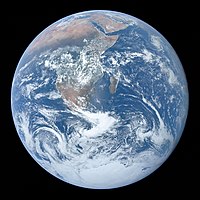
Photo from wikipedia
Earth’s surface topography is a direct physical expression of our planet’s dynamics. Most is isostatic, controlled by thickness and density variations within the crust and lithosphere, but a substantial proportion… Click to show full abstract
Earth’s surface topography is a direct physical expression of our planet’s dynamics. Most is isostatic, controlled by thickness and density variations within the crust and lithosphere, but a substantial proportion arises from forces exerted by underlying mantle convection. This dynamic topography directly connects the evolution of surface environments to Earth’s deep interior, but predictions from mantle flow simulations are often inconsistent with inferences from the geological record, with little consensus about its spatial pattern, wavelength and amplitude. Here, we demonstrate that previous comparisons between predictive models and observational constraints have been biased by subjective choices. Using measurements of residual topography beneath the oceans, and a hierarchical Bayesian approach to performing spherical harmonic analyses, we generate a robust estimate of Earth’s oceanic residual topography power spectrum. This indicates water-loaded power of 0.5 ± 0.35 km2 and peak amplitudes of up to ~0.8 ± 0.1 km at long wavelengths (~104 km), decreasing by roughly one order of magnitude at shorter wavelengths (~103 km). We show that geodynamical simulations can be reconciled with observational constraints only if they incorporate lithospheric structure and its impact on mantle flow. This demonstrates that both deep (long-wavelength) and shallow (shorter-wavelength) processes are crucial, and implies that dynamic topography is intimately connected to the structure and evolution of Earth’s lithosphere. The structure of the lithosphere and its impact on mantle flow significantly influence the impact of Earth’s interior dynamics on surface topography, suggest statistical analyses of Earth’s topography.
Journal Title: Nature Geoscience
Year Published: 2019
Link to full text (if available)
Share on Social Media: Sign Up to like & get
recommendations!